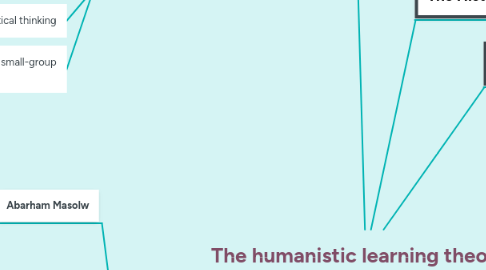The humanistic learning theory
by Maryam S


1. Focus of Humanistic Education
1.1. Self-directed learning
1.2. Self-evaluation
1.3. Independent learning
1.4. Students create their own realistic goals
1.5. Boost self-reflection and critical thinking
1.6. Promote cooperative and small-group learning
2. humanistic psychologist
2.1. Abarham Masolw
2.1.1. Maslow's Hierarchy of Needs
2.1.1.1. Physiological Needs
2.1.1.2. Safety and Security
2.1.1.3. Love and Belonging
2.1.1.4. Self-Esteem
2.1.1.5. Self-Actualization
2.1.1.6. Knowledge and Understanding
2.1.1.7. Need for Aesthetics
2.1.1.8. Transcendence
2.2. Carl Rogers
2.2.1. The Fully Functioning Person
2.2.1.1. Open to experience
2.2.1.2. Existential living
2.2.1.3. Trust feelings
2.2.1.4. Creativity
2.2.1.5. Fulfilled Life
2.2.2. Theory of Personality
2.2.2.1. Self Worth
2.2.2.2. Self-image
2.2.2.3. Ideal Self
2.2.3. Rogerian Therapy
2.2.3.1. supportive, not reconstructive
2.2.3.2. uses the strategy of reflection
